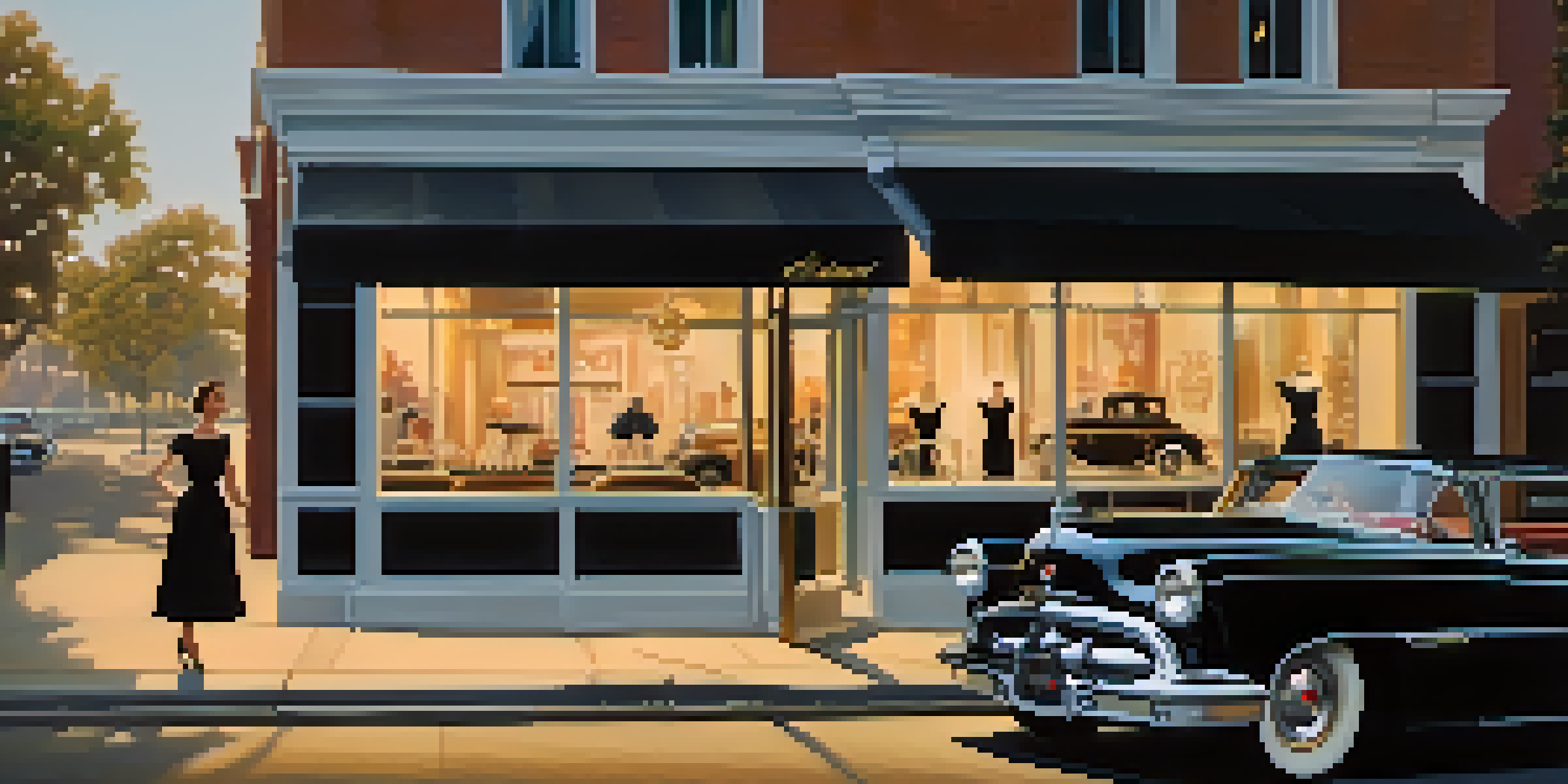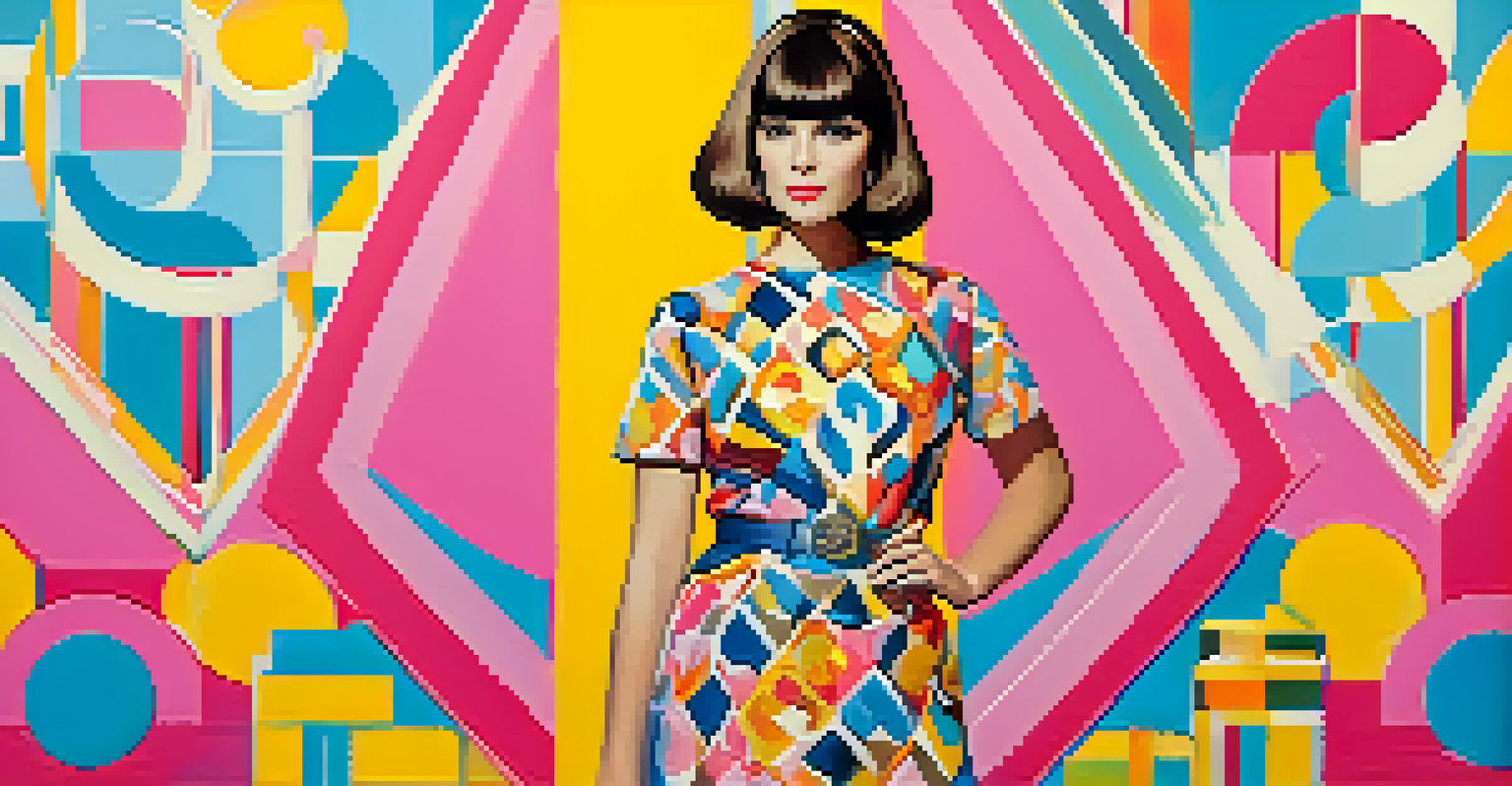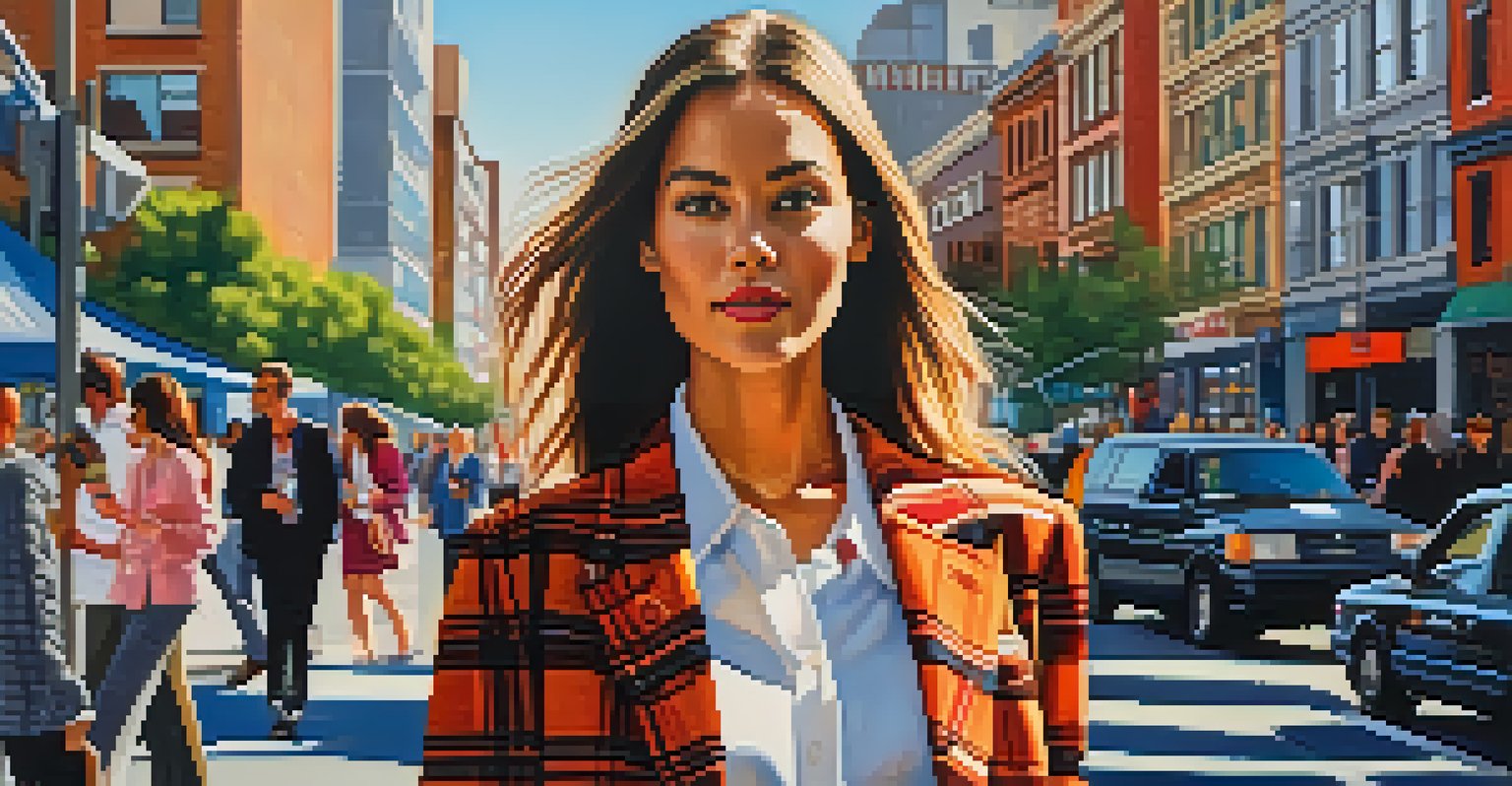Iconic Vintage Fashion Films: Style Inspiration Through Cinema

The Glamour of the 1950s: A Cinematic Era
The 1950s was a decade marked by glamour, elegance, and bold styles, perfectly captured in films of the era. Movies like 'Breakfast at Tiffany's' showcased the iconic looks of Audrey Hepburn, whose little black dress became a timeless staple. The film not only highlighted fashion but also introduced the concept of personal style, inspiring audiences to embrace their individuality. This era's fashion was characterized by full skirts, fitted bodices, and luxurious fabrics, making it a visual feast for fashion enthusiasts.
Fashion is the armor to survive the reality of everyday life.
Hepburn's portrayal of Holly Golightly illustrated how clothing could reflect one's personality and aspirations. The classic blend of sophistication and playfulness in her wardrobe serves as a reminder of how fashion can tell a story. Inspired by the elegance of this era, many modern designers still draw from the 1950s, infusing contemporary pieces with vintage charm. This timeless influence continues to resonate, proving that great style never truly goes out of fashion.
Moreover, the 1950s opened doors for designers like Givenchy and Dior, whose creations became synonymous with Hollywood glamour. The impact of these films extended beyond the screen, shaping everyday fashion choices for women everywhere. Nostalgic references to this period are frequently seen in today’s fashion trends, making it a rich source of style inspiration for anyone looking to enhance their wardrobe.
The Bold Colors of the 1960s and 70s
The 1960s and 70s heralded a shift towards bold, vibrant colors and innovative designs that challenged traditional norms. Films like 'The Graduate' featured striking patterns and mod styles that reflected the youth culture of the time. With characters like Mrs. Robinson, portrayed by Anne Bancroft, viewers were introduced to a more daring approach to fashion, which often combined sophistication with a hint of rebellion. This era is celebrated for its creativity and willingness to experiment with different fashion statements.

During this time, the iconic miniskirt became a symbol of liberation, empowering women to express themselves through their clothing choices. Designers such as Mary Quant and Pierre Cardin pushed boundaries, encouraging a playful take on fashion that resonated with the youth of the day. As films depicted these trends, the audience was inspired to embrace their own unique styles, paving the way for future generations to explore self-expression through fashion. Vibrancy and individuality became essential elements of style.
Fashion Reflects Personal Identity
Throughout cinematic history, fashion has served as a powerful means for characters to express their individuality and aspirations.
Additionally, the influence of counterculture movements brought about an eclectic mix of styles, from bohemian to punk. These films not only showcased fashion but also served as a canvas for social commentary, intertwining style with the cultural revolutions of the time. Today, the bold aesthetics of the 60s and 70s continue to inspire fashion designers and enthusiasts alike, making them a vital reference point for contemporary style.
The Timeless Elegance of the 1980s
The 1980s was a decade defined by extravagance and bold fashion choices, as seen in films like 'Pretty in Pink' and 'Working Girl.' These movies highlighted the importance of personal style, with characters often using their clothing to assert their identity and social status. The era embraced bright colors, oversized silhouettes, and statement accessories, allowing individuals to express their unique personalities through their wardrobe. The impact of these films on fashion was profound, inspiring a generation to embrace flamboyance and self-confidence.
Clothes mean nothing until someone lives in them.
In 'Pretty in Pink,' the contrast between Andie's thrifted looks and the more polished styles of her peers showcased the power of fashion as a form of self-expression. This not only resonated with young audiences but also encouraged them to embrace their individuality. Additionally, the prominence of power suits in 'Working Girl' signified a shift in women’s roles in the workforce, blending femininity with authority. The 80s, therefore, became a pivotal moment in fashion history, where style met empowerment.
Moreover, the iconic hairstyles and makeup trends of the 80s have made a resurgence in modern fashion, highlighting the decade's lasting influence. Today, we often see nods to this bold era in contemporary collections, reminding us of the power of fashion to inspire and transform. The 1980s taught us that style can be both fun and empowering, encouraging us to embrace our uniqueness in every outfit we choose.
The Chic Minimalism of the 1990s
The 1990s brought a refreshing shift towards minimalism, as showcased in films like 'Clueless' and 'The Matrix.' This era celebrated understated elegance, with clean lines and a focus on quality over quantity. Characters like Cher Horowitz became style icons, effortlessly combining chicness with a playful twist. The 90s also introduced the concept of 'grunge,' which influenced a generation to embrace a more relaxed, comfortable approach to fashion.
In 'Clueless,' the iconic plaid skirts and tailored blazers inspired a wave of youthful fashion that emphasized individuality. The film showcased how a polished look could be both stylish and accessible, appealing to a wide audience. Meanwhile, 'The Matrix' introduced a darker, edgier aesthetic featuring sleek leather and futuristic silhouettes. This juxtaposition between light and dark styles highlighted the versatility of fashion in the 90s, showing that minimalism could take many forms.
Cinema Shapes Fashion Trends
Films have a lasting influence on fashion, inspiring contemporary designers to incorporate vintage styles into modern collections.
The 90s also saw the rise of supermodels and the prominence of streetwear, further shaping the fashion landscape. These influences are still prevalent today, as contemporary designers often draw inspiration from the minimalist trends of that decade. As we continue to navigate our own style journeys, the 1990s remind us that sometimes less truly is more, offering timeless lessons in fashion simplicity.
Fashion as Art: The Aesthetic of Period Films
Period films have a unique way of bringing history to life, and with it, the fashion of bygone eras. Movies like 'Pride and Prejudice' and 'The Great Gatsby' showcase the intricate details and craftsmanship of clothing from different times. These films are not only visually stunning but also serve as a source of inspiration for modern fashion, highlighting how historical styles can influence contemporary looks. The attention to detail in these films often leaves viewers in awe, making them appreciate the artistry behind fashion.
In 'Pride and Prejudice,' the Regency-era costumes are a testament to the elegance and sophistication of the time. The flowing silhouettes and delicate fabrics transport viewers to a world where fashion was an expression of social status and personal identity. Similarly, 'The Great Gatsby' captures the opulence of the 1920s, showcasing lavish dresses adorned with beads and fringes that epitomize the Jazz Age. These rich visual experiences provide a treasure trove of style inspiration for those who appreciate vintage aesthetics.
Moreover, the resurgence of vintage-inspired fashion in recent years can be traced back to the popularity of period films. Designers often look to these cinematic masterpieces for inspiration, incorporating historical elements into their collections. As we explore the world of fashion through cinema, it becomes clear that style is not just about clothing; it's a form of art that reflects culture, history, and personal expression.
Influential Style Icons from Film
Cinema has gifted us with countless style icons whose influence transcends their respective films. Characters like Holly Golightly from 'Breakfast at Tiffany's' and Scarlett O'Hara from 'Gone with the Wind' have left indelible marks on the fashion landscape. Their unique styles continue to inspire designers and fashion enthusiasts, reminding us of the power of character-driven fashion. These icons not only represent the aesthetics of their time but also embody the spirit and struggles of their narratives.
Holly’s signature look, characterized by her elegant LBD and pearls, has become a symbol of timeless chicness. Meanwhile, Scarlett’s dramatic gowns and Southern belle charm showcase the lavish fashion of the antebellum period. The way these characters are styled tells us much about their personalities and the eras they inhabit, making them unforgettable. Their influence extends beyond the screen, as fans and followers often replicate their looks for modern wear.
Period Films Inspire Modern Styles
The intricate fashion showcased in period films highlights the artistry of clothing and continues to inspire today's fashion enthusiasts.
Furthermore, the legacy of these style icons is evident in how contemporary fashion often pays homage to them. Today’s fashionistas frequently draw inspiration from these characters, adapting timeless styles for their wardrobes. As we celebrate these cinematic figures, we also recognize the profound impact they have on our fashion choices, proving that the intersection of film and fashion is a vibrant tapestry of inspiration.
The Lasting Impact of Fashion in Film
The intersection of fashion and film has shaped our understanding of style in profound ways, influencing trends and individual choices alike. Movies have the power to elevate fashion, turning outfits into cultural phenomena that resonate with audiences. The way characters dress can evoke emotions and tell stories, making fashion an integral part of filmmaking. As viewers, we often find ourselves inspired by the looks we see on screen, eager to incorporate those elements into our own lives.
Moreover, iconic films often spark trends that ripple through society, as seen with the resurgence of vintage styles. Fashion designers frequently reference films when creating new collections, blending classic elements with contemporary twists. This dynamic relationship ensures that the influence of cinema on fashion remains strong, continually inspiring new generations of style enthusiasts. The vibrant dialogues between films and fashion serve as a reminder that both are forms of art, capable of sparking creativity and self-expression.

As we engage with film, we are invited to explore our own identities through fashion. Whether we draw inspiration from a specific character or a particular era, the world of cinema offers endless possibilities for style exploration. Ultimately, the lasting impact of fashion in film is a testament to its power to inspire, transform, and connect us all through the universal language of style.